ASUS Zenbook Prime (UX21A) Review: The First of the 2nd Gen Ultrabooks
by Anand Lal Shimpi on May 22, 2012 2:46 PM EST- Posted in
- Laptops
- CPUs
- Asus
- Ivy Bridge
- Zenbook
- Zenbook Prime
- Ultrabook
- Notebooks
The Test
To keep the charts clean and simple I omitted a lot of the config details of each of the notebooks. For your reference, here's the configuration of each of the notebooks in our tests:
Dell Inspiron 11z (SU4100 + GMA4500 + HDD + 56Wh)
Performance
As I mentioned earlier in this review/preview, the deal ASUS worked out with Intel prevents us for discussing clock speeds or specifications of the ULV Ivy Bridge silicon in the Zenbook Prime. Obviously the silicon is going to fit within the same 17W TDP as its predecessor so don't expect huge differences in clock speeds.
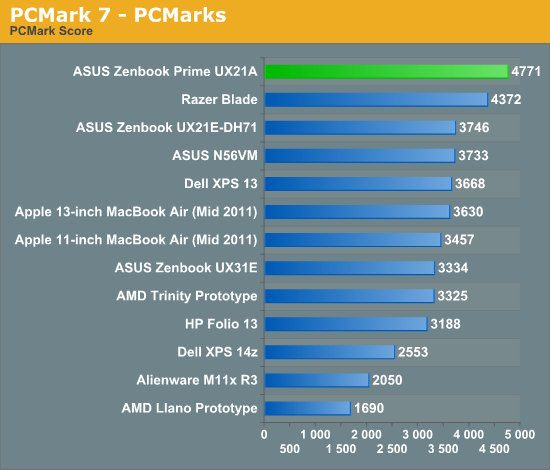
If you take into account Quick Sync and its SSD, the Zenbook Prime is an extremely quick solution. Looking at the breakdown of PCMark scores you get a much more realistic look at where the ULV IVB fits into things.

In some areas the Sandisk U100 holds the Zenbook prime back, here it's actually slower than its predecessor. Despite all of its issues throughout most of last year, SandForce was always fast.

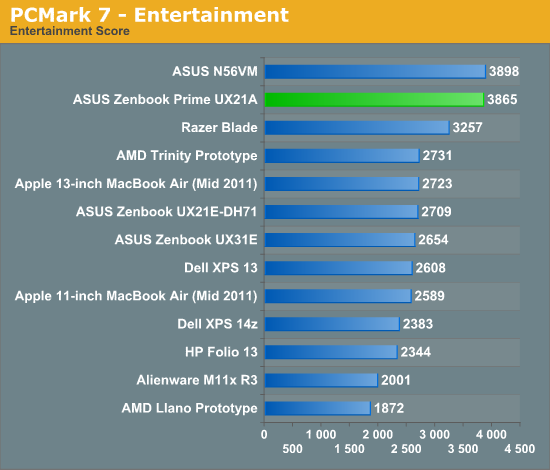

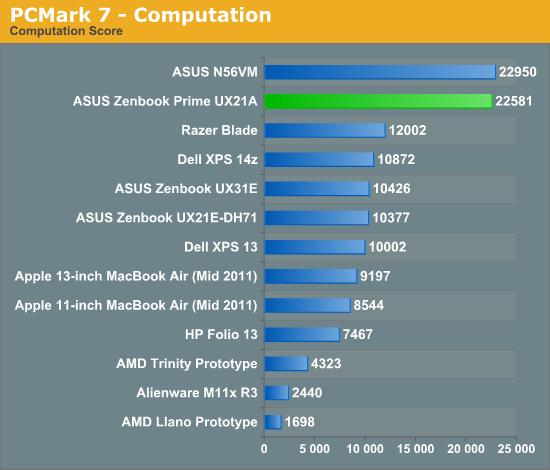
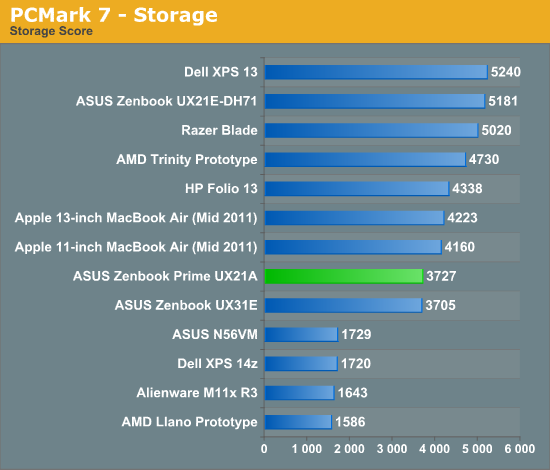
I threw in a PCMark Vantage graph as we have a lot of older data in that benchmark that can help put things in perspective:
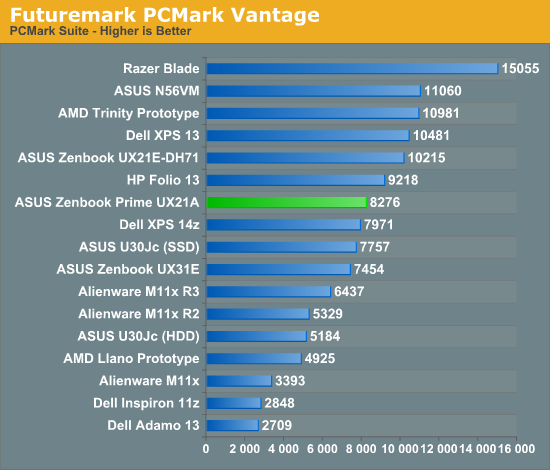
It's amazing the sort of performance gains we're able to show over the older Core 2 based ultra portables like the Dell Inspiron 11z and Adamo 13. Again we see a slight performance deficit versus the SandForce based UX21E.
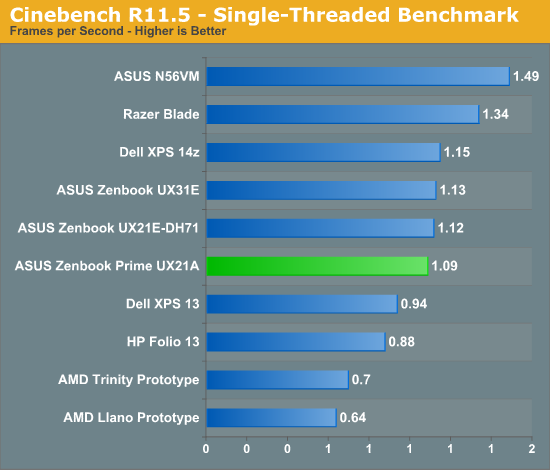
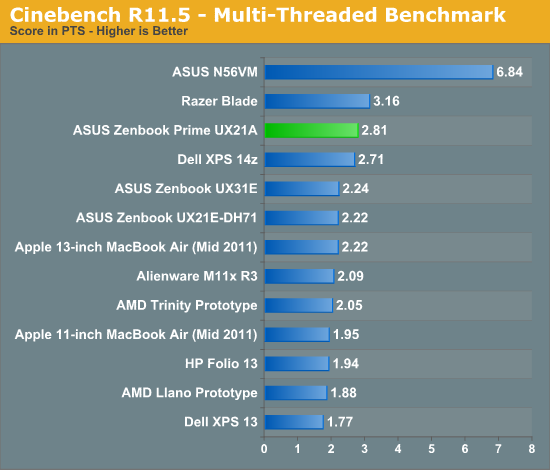

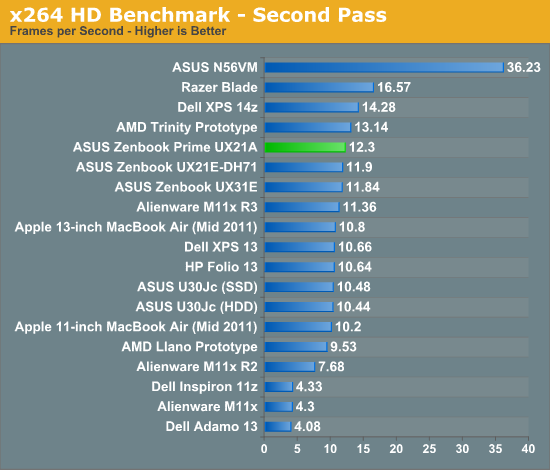










192 Comments
View All Comments
puppies - Tuesday, May 22, 2012 - link
Name a single game that you will run on this product that uses more than 4GB of RAM.Your usage needs are so far from the norm that you might aswell forget finding something that satifies your criteria.
Or is this some weak attempt at trolling by pointing out what a low power ultra book can't do because it was never designed to do it in the first place.
r3loaded - Tuesday, May 22, 2012 - link
"ASUS, people do more than web surf and face book on their laptops."Actually, that's what the vast majority of people do. What, you thought those spoilt students with MBPs were using them for computationally intensive tasks?
ImSpartacus - Wednesday, May 23, 2012 - link
I can vouch that most users do just that. We can include this user as well (with his MBP). >_>rosege - Thursday, May 24, 2012 - link
I agree - hence im looking at the UX32VD-DB71 - though would really have liked 8GB - think the onboard should have been 4 then have the option to add another 4only 4gb in the other models is a major weakness imho
sheltem - Tuesday, May 22, 2012 - link
Why can't Asus just include two mini displayports and call it a day? I understand why people still use full size VGA, but mini VGA is just retarded; you're going to need a dongle anyway.MobiusStrip - Tuesday, May 22, 2012 - link
That is pretty annoying. A DP-to-HDMI adapter is under $5.ka_ - Tuesday, May 22, 2012 - link
Not sure but I understand Displayport essentially is the same as thunderbolt which essentially let any connected device bypass the entire security of your system the same way firewire did, so no thanks until that issue is resolved.I do agree however that having mini connectors - expecially for HDMI which already is small is a worry. Most mini-firewire connectors I have had in the past failed over time as I happen to bring my machine back and forward to work and clients. I think I will connect a screen way more frequently than I connected my external Firewire devices in the past.
VGA I understand had to be shrunk here, but why shrink the already small HDMI port?
Kevin G - Tuesday, May 22, 2012 - link
Thunderbolt tunnels PCI-e which has access to memory as any add-on board would. DisplayPort on the other hand mainly handles video output with options for audio and basic IO tunneling (think keyboard, mouse, touch screen etc.).Penti - Wednesday, May 23, 2012 - link
DisplayPort has nothing to do with Thunderbolt you freaking egghead! It's not connected to any system bus. When used in conjunction with Thunderbolt (PCIe) it uses a cable that carries both signals in the same Thunderbolt (Not DP!) cable. DP-devices can however never connect to the Thunderbolt hardware, which is why it also costs quiet a bit. You can get your normal TMDS SINGLE/DUAL-LINK DVI-D, VGA, HDMI or just plain digital DisplayPort via adapters as it's all compatible with those. A DisplayPort to HDMI cable, or DVI (same signal no sound) or adapter costs nothing and comes included in many computers or graphics adapters. All modern monitors uses it now and there are adapters and converters for legacy stuff as well. Most modern GPU's don't have the option to have dual or quad dual-link DVI any more. I also don't know why you would like to clutter up your notebook with 3-4 different ports that will need cables and so on any way.There are no issues to be resolved with Thunderbolt any other extension involving system buses has worked the same way, there are eventually software fixes to be had, but we will not fully virtualize the address space here and just as we can shut off USB-ports enterprises will probably be able to shut off Thunderbolt functionality in firmware. However they are essentially invisible PCIe switches now that the firmware doesn't touch and that is it's strength. It's no different then to put in an Expresscard accessory in your computer. If you have physical access you have physical access, you could just as well open it up and connect to the PCIe bus of the Mini PCI-Express slot. You also don't need the DMA-vector for cold boot attacks against your encrypted hard drive so it is an entirely pointless discussion. Plus it's just as hard to use as a attack and delivery mechanism as any internal PCIe chip is. You better not use any add in boards in stationary computers either I guess. This is not an Apple we don't ask for DisplayPort for the sake of DP + Thunderbolt, we ask for it because it is the only modern video interface and is natively compatible (well the gpus are, and the cabling can be adapted to whatever you need and are designed to carry those signals) with HDMI, DVI and VGA. Which is all you need. You do need DisplayPort, or a business laptop with a docking station and dual-link DVI support or active DisplayPort to dual-link DVI converter to drive anything over 1920x1200 on a laptop (3GHz HDMI 1.4a will go higher and is supported as of very lately but not by computer displays yet.). You can't try to force all that through a HDMI-connector with the same universal compatibility, versatility, better to have two mini-DP's if you like to drive a couple of displays without daisy-chaining.
KZ0 - Tuesday, May 22, 2012 - link
Truly impressive. Just DPI scaling remaining, then. Only thing holding me back is that I can't really complain about my current computer.